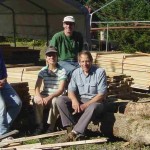Lately I’ve been immersed in the subject of forest management planning. From developing a website that helps landowners navigate the process of creating a forest management plan; to collaborating on a revised set of management planning guidelines for Oregon; to teaching Mentored Management Planning workshops; this has been a major theme of my work over the past year.
So I was interested to come across a recent article about management planning in the Oregonian. The article described the management plan that is in place for the city of Forest Grove’s 4,200 acre forested watershed, and the positive impacts that having the plan has had on the land. Though this forest is much bigger than those that most small woodland owners manage, the article demonstrated many of the same principles of forest management planning that I use in my courses.
Management planning starts with identifying goals for the site. The number one goal in the case of Forest Grove’s watershed is, not surprisingly, protecting drinking water quality. Biodiversity and sustainable timber management are secondary goals. These goals drive all of the actions called for in the plan – such as road rehabilitation, erosion control, and carefully planned timber harvests.
Forest management planning has evolved over time. In the 1970’s and ’80’s, most forest management plans were concise timber management plans – laying out succinct timelines for planting, weed control, thinning and clearcut harvest to optimize wood production. Nowadays we take a much more holistic approach. Today’s plans consider all the different resources on a given piece of land – timber, of course; but also recreational resources, streams, fish and wildlife, roads, aesthetics, soils, and much more. We recognize that most landowners value many other aspects of their property as least as much as the timber resource. Well-constructed plans reflect the suite of values of the landowner and place emphasis on them appropriately.
The other important management planning principle that I took note of in the article was the fact that the plan is being updated, ten years after it was originally written. It is a good idea to revisit one’s plan after a time, both to check that the goals are still relevant and to recognize the progress that has been made towards achieving them.








